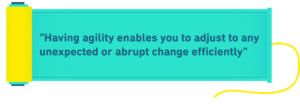
Nov 1, 2019 | Business Strategy, Design, Insight, Strategy
Visual management utilises instinctive visual cues to convey accurate information in a succinct way. This enables management, employees and customers to receive key information at a glance.
Studies show that people remember as much as 80% of the things they see and do but only remember 10% of the things they hear and only 20% of the things they have read.
Visuality is the process of seeing or looking, but has a clear purpose, is more critical and direction oriented than merely seeing. It applies to our sensory perception and how information can be communicated quickly and effortlessly by using mainly our human sense of sight as well as our other senses. An easy to understand example of visuality and how visual perception relates to the immediate understanding of certain concepts is the white or yellow lines on a road.
Visual Management is about communication
Signs and other visual cues are put in place to help employees and customers make sense of the organisational context or business by merely looking around. Visual Management in the workplace gives structure to the space and enables the easy flow of work processes.
All it takes to understand certain operations is to look around. It is a management system that tries to improve the performance of an organisation or business. Visual Management does this by connecting and aligning the vision of the organisation, its core values, culture and goals with other work place related elements such as management systems and work processes by using human sensory experiences. These stimuli directly engage one or more of our five human senses: sight, sound, smell, taste and touch.
Benefits of Visual Management
Using Visual Management can entice staff to be more creative thinkers. Using Visual Management also means that the environment is constantly communicating with the employees and customers. This can lead to bottom-line improvements as well as improved safety in the organisation. Visual Management also helps with company-wide alignment and unity.
By displaying the current progress of projects for all to see, top management is able to receive progress information every time they look at the display. Not only does this indicate what the progress on each project is, it also indicates to staff what the next steps are as well as how to go about achieving the rest of the project objectives.
Secondly, using Visual Management encourages employee engagement by allowing ownership of goals and creating or increasing motivation among the employees. Visual Management is non confronting in its approach, but it does demand authority and represents the real time factual status of projects. It embeds a culture of continual development and improvement in every aspect of the company.
Thirdly, Visual Management can be used to convey transparency in an organisation. By having it out in the open, no information is hidden. This means that the goals and progress of the project is shared openly and they company is united in achieving these goals.
Visual Management might seem like a foreign concept to grasp, but the application thereof is without a doubt incredibly practical. Visual Management is an easily applied practical concept that could improve everything in a business, from the bottom-line through to overall company morale, overall company safety and transparency.
References:
Tezel, A., Koskela, L. J., Tzortzopoulos. (2009). The Functions of Visual Management. Conference Paper.

Sep 18, 2019 | Design, Future Skills, Insight, Strategy
Whether you’re an entrepreneur, executive, expert or an educator, we’re all increasingly being asked to make decisions about our impact – and the impact of the companies and organizations we work or interact with. More and more companies and organizations are talking about impact and aspiring to create it. Yet, our shared approaches to systematically collecting impact data and making decisions based on it – are still inadequate or confusing.
From accountability to impact
The term impact has often been defined to refer to significant or lasting changes in people’s lives, brought about by a given action or series of actions. Since the early 1990s, the requirement of accountability has been ascendant. A more recent manifestation of this discussion has centered on impact, or demonstrating evidence of how much difference you’re making.
Metrics & alignment
Harvard Business School professors Ainoor Ebrahim and V. Kasturi Rangan argue in their article that it is not feasible, or even desirable, for all organizations to develop metrics at all levels of a results chain, from immediate outputs to long-term societal impacts. Their claim is that the more important challenge is one of alignment: designing metrics and measurement systems to support the achievement of well-defined mission objectives. According to them, impact is better measured at the higher, systemic level, leaving the individual organizations to do what they do best — focus on their more specific missions.
Two types of impact
There are however two different types of impact that we need to take into account: Program-level impact is the impact that individual services have on the people who directly participate in them. Community-level impact is the impact that many different partners, working in collaboration, have on a specific population (community, town, state. etc.) Individuals and organizations can only be held responsible for the performance of the programs and services that they manage.
Impact for learning
When it comes to learning, it is important to try to grasp the impact of your efforts on a program-level. Let’s say you organize a series of coaching sessions aimed for all the managers in your company. The usual way to follow up on this kind of initiative is to focus on the numbers: i.e. how many of all the managers have participated the coaching. Now, this is all well and fine, but instead of settling for the reach in numbers, we should also be able to get an idea of what changes after the coaching. Did the managers adapt newly acquired skills to practise? Can the team members or colleagues tell the difference? It is precisely these kinds of questions we need to address in order to gain insights on the depth of impact for our learning efforts.
Impact tools & frameworks
While this may sound like an overly complicated a task, there are tools and frameworks that can help you better understand and accomplish this.
With the help of technology we can collect data from end users more efficiently. We can then extract insights in ways that allow us to better serve our customers and achieve more impact.
Another possibility that can help in our impact efforts is systems practice. It is an approach that can help to gain clarity about your environment as a dynamic system. It also provides an approach to effectively learn and adapt your understanding of your system and the impact your trying to achieve.
Impact analysis frameworks have also evolved from assessment of immediate results to measuring longer term outcomes and impacts. While these include various different philosophies and approaches from expected return methods to theory of change and lean data, they are not mutually exclusive. In many cases it is good idea to figure out which approaches are most suitable to your project and then combine several of them accordingly.
Ultimately learning about impact is grounded in a simple activity: listening to open and unbiased feedback from our customers and end users. Rather than a separate project, impact is something to be continuously pursued. It is also a key to finding sustainable solutions and designing growth – be that on a business, community or individual level.

Aug 16, 2019 | Business Strategy, Insight, Strategy
In order for us to explore this concept, we have to fist look at what agility in business means. The marketplace is changing rapidly due to never ending and never subsiding improvements and innovations. Any strategy a business uses needs to be more fluid, rather than concrete. Organisations, businesses and brands need to shift their approach to adapt new values. This will help them to establish a mindset focused on collaboration. When leaders are more focused on co-creating and collaboration, they are more involved in the process, not just watching it unfold.

Vision + flexible roadmap
Of course you need to have a plan or roadmap when you are creating and executing any strategy. What is important here is that you, as a business or strategist, need to ensure that your plan or roadmap is flexible. Having flexibility will enable you to respond quickly, calmly and effectively to any change you might encounter. Having agility enables you to adjust to any unexpected or abrupt change efficiently.
Your company vision will always form the backbone of any strategy or plan that your organisation, business or brand employs. It serves to direct your long-term constant achievement and relates hugely to your business’ purpose. Having innovation as a value enables your company to be flexible and have an open approach to explore new offerings in your field. It also enables your organisation, brand or business to experiment and explore which of the new offerings serves your organisation, business or brand best.
Agile strategy is transformative
From the moment you adapt an agile strategy process, you should be seeing changes. Conduct your strategy in sprints rather than in marathon sessions that may take years to complete. This does not mean that you need to chuck your current strategy out of the window. When you break up an enormous task or plan into smaller, more achievable sections, it becomes easier to complete and upon completion of each smaller task, a sense of rewarding is felt by the parties involved. This helps with keeping a team motivated and inspired and helps to keep company morale high.
When you change your outlook from long term projects to shorter-term end goals, you reduce stagnation. Boredom is eliminated and the environment is conducive to productivity. When individuals know there is a short time to complete their goals, (from one day, days, weeks to at most a few months), they are more likely to give their all for the short duration of the project. Employing and executing your strategy in this manner helps people to think on their feet and further allows for innovative and creative thinking as well as problem solving.
Effective implementation of strategy
In order to execute your strategy sprint effectively, you have to have a clear and specific goal or problem in mind. You have to define the rules, explain the process and set the time constraints appropriately. If you expect your team to do too much they might burn out and the whole aspect of incorporating agility in your strategy process will flop. It is important to create a safe space where everyone is given the opportunity to speak their mind and have their voice heard without discrimination. Creative and innovative solutions often come from unexpected sources or contributors. Lastly, make sure to record the whole process, due to the time limit, every word is important and should be used to facilitate the process.




